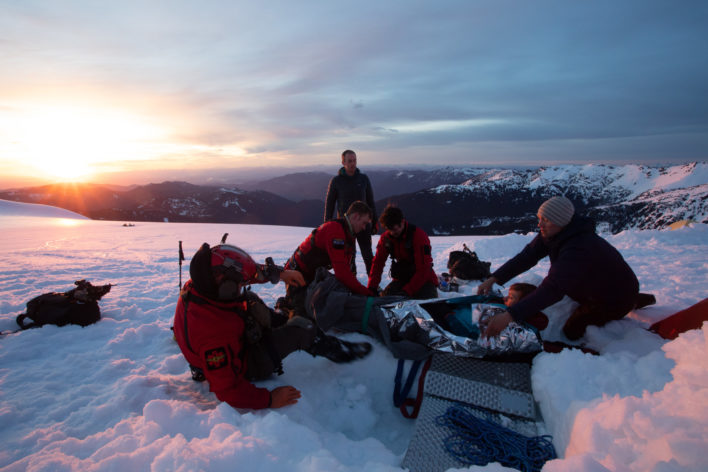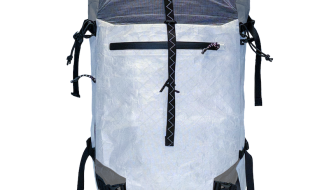“Do you have any painkillers?”
A strained voice called out across the Coleman Glacier, one of the most direct routes up Washington’s volcanic Mt. Baker in the North Cascades, as my party of three skinned under the weight of overnight packs and the withering late afternoon sun of an unseasonably warm May weekend.

[Photo] Matt Bunker
As we approached where the voice emanated from, we found Holly Spangler Beale struggling to scoot down the mountain, her left leg braced with pickets. After successfully reaching the summit earlier in the day, Spangler Beale and partner Erik Richardson had just started skiing from the Coleman-Deming Col when she twisted her knee while making a turn in grabby snow. In addition to suffering an impact fracture to her femur, she tore her ACL and both meniscuses.
I fished around in my pack for a zip-top plastic bag with six Advil and gingerly tossed them toward Holly. Two months into the COVID-19 pandemic, maintaining physical distance had been drilled into my subconscious. Luckily, the baggie landed close enough, and she downed all six pills in one fell swoop.
We were up in the alpine at 8,500 feet, the trailhead was below tree line at around 3,700 feet, and it was getting late. The prospect of inching all the way down was clearly daunting. We recommended she at least try to reach Hogsback, a moraine crest where a dozen tents made a makeshift village for skiers and mountaineers attempting Mt. Baker over Mother’s Day weekend. Outdoor recreation is now permitted under Phase 1 of Washington’s reopening plan, and plenty of alpine junkies were taking advantage of the tentative green light to ski and climb on one of the state’s most picturesque peaks.
Since mid-March, the outdoor community has struggled with the ethics of going out into the backcountry during a pandemic—if one were to get hurt, the argument went, that would force search and rescue crews to use scarce personal protective equipment (PPE) and break social distancing guidelines, while potentially straining an overburdened health care system. Still, it was easy to imagine myself in the same painful situation as Spangler Beale. Our group urged her to call search and rescue if need be, rather than let any lingering sense of guilt hold her back.
“I was adamant about self-rescue and trying to get down on my own,” Spangler Beale, an accomplished skier from Seattle who has ticked off several iconic objectives in the Pacific Northwest, told me a week later over the phone. “We could make a coffee table book with all the different ways we tried to get down: sitting on a ski, lashing skis together to make a sled, sliding on a shovel, sliding on a sleeping pad, skiing with the brace on.”
None of those ways worked. Instead, in an impressive display of grit and determination, Spangler Beale sucked up the pain and butt scooted her way a couple thousand vertical feet to camp. “My butt is still covered in bruises,” she said.
At Hogsback, another party heading down to the trailhead generously left their tent and sleeping bags in case Spangler Beale’s crew, who were only out for a day ski, had to spend the night. In the end, Richardson decided to activate his inReach and call for a rescue. Around sunset, a helicopter from nearby Whidbey Island Naval Air Station (NAS) soared up the valley, landed on the snowfield and scooped up Spangler Beale.
While in the heat of the moment, Spangler Beale agonized about the accident. “This is exactly why people are being told not to go out right now,” she said when we encountered her on the mountain. The trip was her first backcountry outing since Washington’s stay-at-home order was issued on March 23. The search and rescue crew, however, immediately put her at ease.
“I can’t tell you how caring and just phenomenal the team was,” she said. “They told me not to feel embarrassed or guilty, that shit happens when you play in the mountains, and don’t let the Facebook haters get me down.” (Comments about the incident on the popular Cascade backcountry skiing social media group, Turns All Year, were largely supportive and wished her a speedy recovery.)
The rescue crew echoed that frame of mind. Although they have adopted COVID-19 protocols—everyone masked up for the helicopter flight, and teams are staying on the same rotation with minimal outside contact—Whidbey Island NAS remains the go-to first responders in the North Cascades for technical, high-elevation rescues beyond the capacity of county-level responses. As outdoor recreation was put back on the table in early May and the weather window lined up for alpine pursuits, they expected to get such a call. The day after Spangler Beale’s rescue, the helicopter raced to Mt. Stuart to pluck off a skier who broke his leg.
For a group who executes civilian rescues to prepare for their primary mission of rescuing naval aviators, they welcomed their first mission in over a month in the best possible training ground. “We train for overland and overwater search and rescue medical evacuations, including high-altitude mountain flying procedures, and we are outdoor enthusiasts just like our rescues,” said Lt. Andrew Soberman, pilot and public affairs officer. “These kinds of rescues are the pinnacle of our career.”
Still, many skiers and ski mountaineers are picking up their spring skis and ice axes for their first backcountry forays since they were strapping into fat skis to chase powder. Given the seasonal changes in weather and snow conditions, let alone those brought on by a pandemic, SAR organizations generally recommend a cautious approach for the public this spring.
“This isn’t the time to go and bag the peak that is probably above your level but you want to attempt it anyway,” said Naval Aircrewman Christopher Harris, who was the crew chief on the Mt. Baker rescue. “None of us would ever say [a skier] violated a stay-at-home order, let them die in the mountains. That’s not why we do SAR. But the message is for people to be smart about what they’re doing.”
It’s a sentiment echoed across the nation’s backcountry hotspots. While Wyoming never issued a stay-at-home order, Teton County did, though few expected the Teton faithful to hang up their skis for the season in March. “We knew people were going to continue backcountry skiing, so we were just encouraging people to be extra cautious,” said Matt Hansen, communications director for Teton County Search and Rescue (TCSAR). With local resorts and Grand Teton National Park closed (the park began reopening on May 18), most Jackson residents switched over to cross-country skiing or hiking up Snow King. Despite a relatively quiet spring, the team did respond to an avalanche fatality on Mt. Taylor in early April, the same week Teton Pass ambassador Jay Pistono counted a record 650 cars.
With the extra down time, TCSAR has been fundraising for its helicopter. “The team is always going to be here and be ready,” Hansen said. “The new normal for outdoor recreation is building in extra margins for safety in decision making and route choices.”
As May warps up, mountain biking and whitewater are luring athletes to other seasonal pursuits even though, Hansen said, “There is still a ton of snow in the Tetons.”
A healthy spring snowpack is less the case for California’s Eastern Sierra, where a dry season was dealt a dangerous hand when a three-foot April dump atop a season’s worth of facets during California’s stay-at-home order led Inyo County to specifically name backcountry skiing as an activity to avoid. Nevertheless, Inyo County Search and Rescue responded to two avalanche incidents that volunteer Todd Vogel described as “very close calls—I can’t believe the people lived.”
“COVID-19, like any other communicable disease, figures into our planning,” he said, noting that some volunteers might opt out of a rescue because they or a member of their household are in a higher-risk category. “But if there is an accident and a call for help, we will respond.”
Inyo County has not had a new COVID-19 case in 34 days. And while California remains under travel restrictions, Vogel said visitors are slowly coming back, and he’s seen a few people with skis on their back during his mountain jaunts. “Between COVID-19 and the shallow snowpack,” he said, “people have not really been getting back out there.”
As valley trails melt out in the Front Range of the Rockies, Colorado’s Summit County is facing a different scenario than that of late March, when cars thronged Berthoud and Loveland Passes after ski resorts closed. “It was a perfect storm that forced people that aren’t as comfortable into the backcountry,” said Summit County Sheriff Jaime FitzSimons. “We highly discouraged people that didn’t have the skill level or equipment. Thank God we did not see an increase in calls. They either listened or no one got hurt.”
Summit County worked to open up trails and bike paths as soon as snow levels permitted in order to provide a safer recreational outlet. Less March and April snow than usual helped that process along. “We’ve managed to spread out the spots that maybe wouldn’t be open this time of year, because you should get out for your physical and mental health,” FitzSimons said.
Colorado’s stay-at-home order ended on April 26. As for those waxing their skis even when the sun sets after 8 p.m., FitzSimons is less concerned. “Hardcore people who backcountry ski all summer are different from the people who were caught off guard when the resorts shut down,” he said. While May skiers are likely more prepared, he would still prefer not to send out a SAR crew for as long as COVID-19 remains a risk. “While the virus is still going on we’re trying to limit person-to-person contact,” he said. “We continue to remind people to recreate safely so that we don’t have to unnecessarily send people into the field.”
In the North Cascades, it’s ultimately the underprepared skiers tackling objectives beyond their ability who irk Whidbey Island NAS’s Harris. “We hate to see people use the SPOT beacon when they don’t really need us or weren’t well prepared, like [those wearing] shorts and running shoes in a high-alpine environment,” he said. “Holly and her team were well prepared. Calling us in was their last resort.”











Related posts: